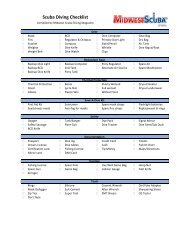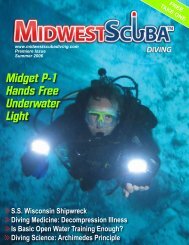DIVE THE DRY TORTUGAS - Midwest Scuba Diving Magazine
DIVE THE DRY TORTUGAS - Midwest Scuba Diving Magazine
DIVE THE DRY TORTUGAS - Midwest Scuba Diving Magazine
- No tags were found...
You also want an ePaper? Increase the reach of your titles
YUMPU automatically turns print PDFs into web optimized ePapers that Google loves.
Simple Principles to be More“Fit for SCUBA” and LifeBy Jessica B. Adams, Ph.D. and Jaime B. Adams, MSmore energy for the dive itself.The first step is to put your eyes toward theceiling, put your arms out in front of you forbalance, and stand up from your chair withoutusing your hands. Sit back down; now try itagain without using momentum to get up fromyour seat. See how many times you can standfrom a seated position in one minute. Try thisevery day. You are moving, hence burningkilocalories. You are also building the musclesused to get out of a chair.Once you are comfortable with this movement,DIVING FITNESSstart standing with your feet shoulder widthapart and try to sit back just touching the chair,but not sitting all the way down. Still be sureto keep your arms out for balance and eyeslooking at the ceiling. Make sure that yourweight is pressed through your heels.When you have mastered this task, practicefor a few days or weeks without the chair.Once this becomes too simple a task, addsmall dumbbells, soup cans usually work justas well in the beginning. Oh, by the way, youare now doing a squat.Snapshot:Jessica and Jaime AdamsWe are bombarded with information and,unfortunately, some misinformation aboutdiet and exercise. Weight loss and fitnessis discussed everywhere from Oprah to thecheckout line at the grocery store and late nightinfomercials. The supplement industry aloneis a multi billion-dollar industry thriving onfads and “quick fixes”. First came 10-minuteabs, then 5-minute abs, then 3-minute abs, andsoon a magic pill. The fact of the matter is thatmost of us have to put forth more precioustime and effort than advertised.Many popular products express the need tochange diet and exercise habits, which isabsolutely true. The effectiveness of mostprograms depends on how much time andenergy you, the consumer, are willing andable to invest. Almost any gadget or dietwill work to some degree if you adhere to afew basic principles of wellness. You canapply this fundamental knowledge of humanphysiology to improve your personal fitness,and increase your quality of life. Fitness is alifestyle change.1: Calories In vs. Calories OutMyth: Calories are bad. Quite the contrary,calories are the fuel for the human body. Justlike most cars cannot run without gasoline,our bodies cannot function without calories.However, unlike a car we store our extracalories as fat to be used later in times offamine.It is a simple fact that a single pound of fatcontains 3500 kilocalories (aka…dreadedCalories). Therefore, for every 3500-kilocaloriedeficit you will lose one pound. This deficitcan occur by cutting kilocalories out of yourdiet, burning them off by exercising, or betteryet a combination of both.If you cut a measly 140 kilocalories (a singlebottle of soda) out of each day and don’tchange any other habits, you can lose onepound every 25 days.You burn at least 100 kilocalories (more forheavier individuals) for every mile that youwalk, jog or run. Yes, you read correctly itdoesn’t matter what speed however the sloweryou travel, the longer it will take. Therefore, ifyou walk a single mile each day you can losea pound every 35 days.Add it up, if you cut out that soda and walk amile each day you will lose a pound every twoweeks. Not too shabby. The more you moveyour body, the more calories you will burn.One to two pounds of weight loss per weekis a realistic goal depending on your initialweight. Weight loss in excess of two poundsper week can typically be attributed to a drasticreduction in kilocalories or dehydration, bothof which have the potential to yield unwantedlong term results.2: Muscle is MetabolicOur body hasn’t evolved quite as fast as ourtechnological environment. Physiologicallyour systems still believe us to be huntersand gatherers. This, my fellow diver, is whywe store fat so readily. We store up in timesof plenty for the inevitable times of few.However, in today’s society those times of fewnever quite seem to happen upon us.Fat is an extremely efficient storagemechanism. We can store 3500 kilocalorieswhile expending virtually no energy. Fat isa non-metabolic tissue. Conversely, muscleis an extremely metabolic tissue (i.e. Musclerequire many calories to exist). Therefore,unless we need muscles, our body is reluctantto make muscles. If our bodies make muscles,we have to expend more energy to sustainthem. In our bodies energy = kilocalories.Muscle is a metabolic tissue. The more muscleyou have, the higher your metabolism. Thehigher your metabolism, the more calories youburn throughout the day regardless of activity.If you increase your muscle mass, you evenburn more calories when you are sleeping.3: Building MuscleSimply pick up some weight, put it down, andpick it up again….then repeat. It is importantto start with light weights and then graduallyprogress to heavier weights as your bodyallows. Start with simple exercises and thenmove on to more challenging versions. The keyis to remember that this is not a day, or a week,or a year, but rather a lifetime commitment toyou.Muscles will help burn calories and makepreparation for your dive easier. A key exampleis the squat. We use the same motion to standup with full gear, as we use in the squat.Therefore, many of the same muscles areused. If you develop the muscles commonlyused in preparation for a dive, you will haveINTERNATIONAL<strong>DIVE</strong> MAGAZINEwww.xray-mag.com<strong>THE</strong> FIRST & ONLY MULTI-NATIONAL <strong>DIVE</strong> MAGAZINE — WORLDWIDE SINCE 2004Read by divers in over 80 countries and produced by dive editors on four continentsX-RAY MAG truly spans the globe, bringing you dive news from Siberia to Patagonia.Dive Travel ▪ News ▪ Equipment ▪ ProfilesScience ▪ Dive Med ▪ Books ▪ AdventureUnderwater Photography ▪ ConservationMarine Ecology ▪ Tech ▪ Wrecks & more!X-RAY MAG is a full-format eco-friendlybi-monthly digital magazine distributedvia the Internet to your email box in pdfformat — printing is optional, saving treesJessica and Jaime Adams are a husbandand wife scuba fitness team.Together, they co-authored “Fit forSCUBA”. Both are scuba instructorsand personal trainers. Jessicais currently an assistant professor inthe physical education department atKean University in Union, NJ. Jaimeis a health and physical educationteacher at Brick High School inBrick, NJ.www.xray-mag.com10 MIDWEST SCUBA DIVING SPRING 2007SPRING 2007 MIDWEST SCUBA DIVING 11










